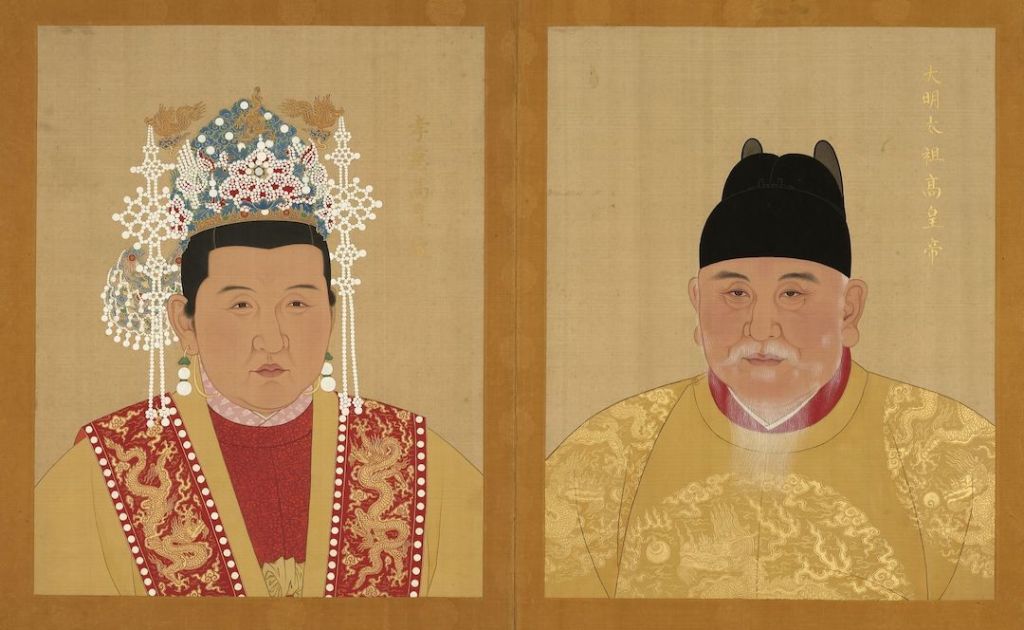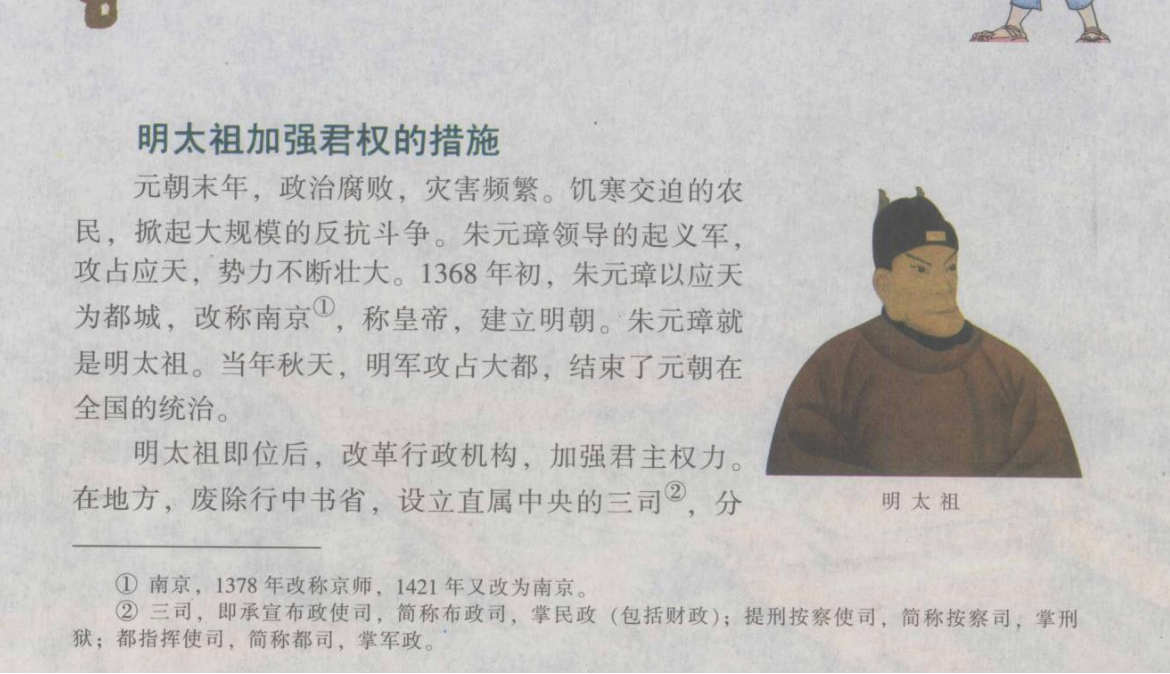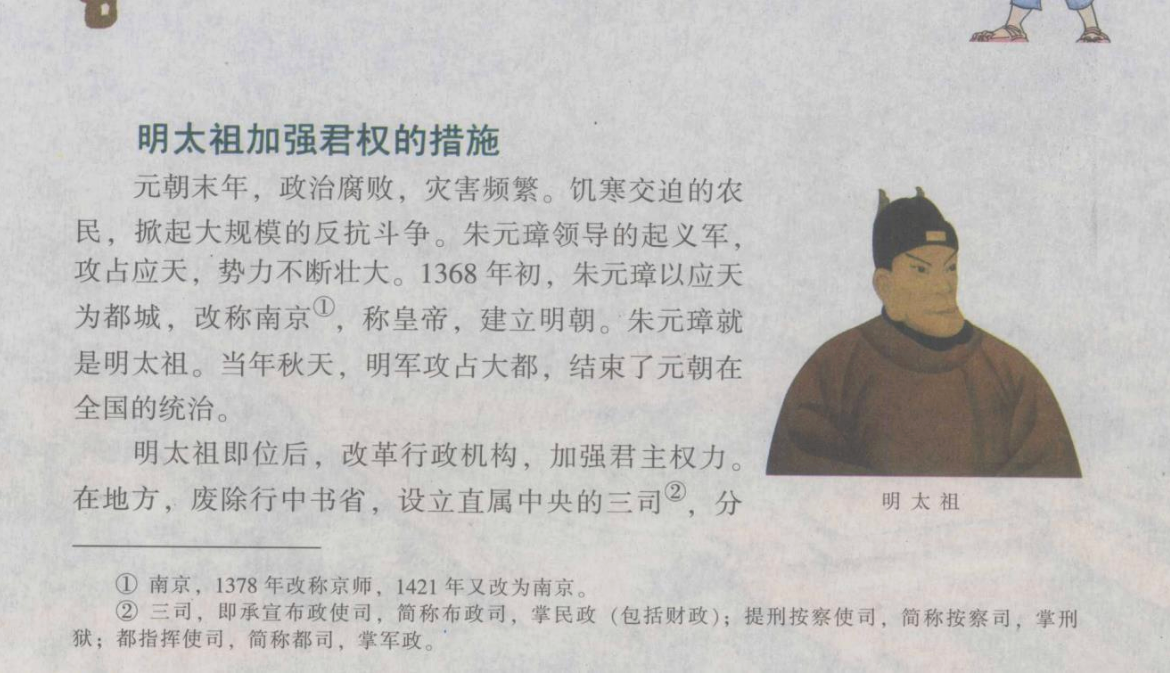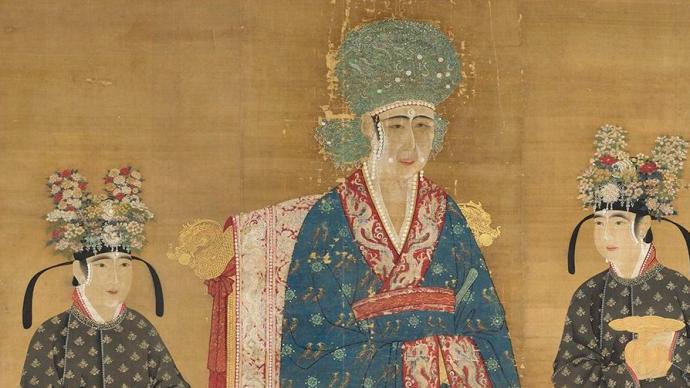
The Paper learned that the "Travel Through Hongwu" exhibition was recently launched at the National Palace Museum in Taipei. The exhibition features portraits of Emperor Taizu Zhu Yuanzhang and his empress, utensils influenced by the Hongwu system, and handicrafts from the period, such as dragon-patterned mirrors and statues of vassal kings, presenting a glimpse of the art of the Hongwu period.
"Hongwu" is the reign title of Zhu Yuanzhang (1328-1398, reigned 1368-1398), the first emperor of the Ming Dynasty. He was born in poverty and used to herd cattle when he was young. When he was a teenager, his parents and brothers died during the Great Famine, so he could only live in a temple and work as a monk. However, in the chaos at the end of the Yuan Dynasty, he defeated Chen Youliang (1320-1363), Zhang Shicheng (1321-1367) and other powerful southern powers, and sent troops to the north to repel Mongolia, thus founding the Ming Dynasty (1368-1644). Due to the dramatic reversal in his life, there are many magical legends about this emperor who was born a commoner, such as the distinctive characteristics of the "stinky-headed emperor" and the "emperor's mouth" that could make things come true when he opened his mouth, and he was affectionately called "Hongwu Jun".
The Ming Taizu in official history had two sides. On the one hand, he cared about people's livelihood, advocated frugality, and was committed to improving the administration of officials; on the other hand, he set strict rules, centralized power, and used heavy punishments and liked killing. As the founding emperor, he also created the rules and regulations of the Ming Dynasty, including stipulating that red was the appropriate color for clothing, and ordered that sacrificial vessels be replaced by porcelain instead of bronze, making red the color advocated by the Ming Dynasty, and porcelain sacrificial vessels became the most important national vessels in the Ming and Qing dynasties. This exhibition selects portraits of the Ming Taizu and his empress, utensils influenced by the Hongwu system, and crafts of the period, such as dragon-patterned mirrors and statues of vassal kings, to present a corner of the art of the Hongwu Dynasty.
The following is an introduction to some of the exhibits:

Ming (1368-1644) Emperor Taizu of Ming and Empress Xiaocigao
Portrait of Emperor Gaozu of the Ming Dynasty (1368-1644) and Empress Xiaoci Gao
This is the first leaf of the album "Portraits of Emperors and Empresses of the Ming Dynasty" formerly collected in the Nanxun Hall of the Forbidden City - Portraits of Emperor Taizu of the Ming Dynasty and Empress Xiaoci. According to the gold-written title in regular script, the figures depicted are Zhu Yuanzhang (1328-1398), the founding emperor of the Ming Dynasty, and his wife, the famous Empress Ma (1332-1382).
In the 12th year of Emperor Qianlong's reign (1747), Emperor Gaozong of the Qing Dynasty discovered a group of portraits of emperors, empresses and meritorious officials stored in the "Tea Storehouse" and ordered them to be repaired and mounted. After the restoration work was completed in the 13th year of Emperor Qianlong's reign (1748), the portraits of emperors and empresses were moved to the "Nanxuan Hall" for storage. This is one of the portraits of emperors and empresses that were repaired and mounted by Emperor Qianlong.

Portrait of Emperor Gaozu of the Ming Dynasty
This painting, titled "Portrait of Emperor Taizu of Ming Dynasty", consists of 12 pieces, of which two show normal appearance, and the period is close to the period of the person in the painting; the other 10 pieces were painted in a more recent period and the style is more folk-oriented, all of which have pockmarked faces and scooped brows, emphasizing the "strange appearance" of this commoner emperor. According to academic research, the strange appearance of Emperor Taizu of Ming Dynasty originated from the flattery and mythology carried out by Emperor Yongle Zhu Di (1360-1424, reigned 1402-1424) to consolidate his regime, and became the mainstream popular among the people. The real appearance of Emperor Taizu of Ming Dynasty became the hidden authentic version used by the palace to commemorate the deceased emperor and offer sacrifices.
In order to achieve realism, the painter painted each beard of Emperor Taizu of the Ming Dynasty separately, one stroke at a time, revealing the collar and robe pattern hidden behind. The slightly raised eyebrows and deep nasolabial folds on his face also capture the majestic and slightly irritable look under his aging appearance.

The painting on the other side is of his wife, Empress Ma, who accompanied him in conquering the world. The "History of Ming Dynasty" records her vividly. Before she became a noble, Ma, as a virtuous wife, once stole sesame cakes to save Zhu Yuanzhang, who was almost starved to death, and burned herself. Although she later became the empress, she still retained the habit of ordinary women taking care of their husbands' food and daily life. When she saw the Emperor Taizu of the Ming Dynasty furiously retiring from the court, she "always gave slight advice on matters", and the palace people praised her as "saintly and kind". The painter used a slightly yellowish skin color with slightly rouge on her cheeks to show the simplicity of Empress Ma, who was born in the common people. The downward lines at the end of her eyes can't help but remind people of her loving mother at home. In addition, the round texture of the empress's jewelry inlaid with red gems reflecting light, the blue-green color changes of the kingfisher headdress, and the outlines of the dragon and phoenix can all be seen to be carefully depicting the dazzling effect of a head full of jewels. The image in the painting is detailed to the beard and hair, and various details are presented with various techniques. It is a faithful portrait carefully drawn by the court painter.

Ming Hongwu Red Glaze Bowl with Hidden Dragon Pattern
Ming Hongwu Red Glaze Bowl with Hidden Dragon Pattern
According to the "Records of Emperor Taizu of the Ming Dynasty", in the third year of Hongwu (1370), Emperor Taizu of the Ming Dynasty ordered that "red should be the preferred color for clothing", and red became the color that was admired by the Ming Dynasty. This bowl is covered with red glaze, with a rich glaze color, a slightly tilted rim, curved walls, a low ring foot, a thin body wall, and an exposed bottom. The outer wall is plain and has no patterns, while the inner wall is printed with a pair of five-clawed dragon patterns, and the center of the vessel is shallowly scratched with a ruyi cloud pattern. Since the five-clawed dragon pattern was an exclusive decoration for the royal family in the Ming Dynasty, combined with the glaze color of the bowl, it is speculated that this bowl has the characteristics of official porcelain.

Ming Hongwu Underglaze Red Three Friends Jade Pot Vase
Ming Hongwu Underglaze Red Three Friends Jade Pot Vase
Underglaze red is an underglaze color that uses copper oxide to create color. It is an important category of porcelain in the early Ming Dynasty. Since copper oxide is sensitive to the temperature and atmosphere during firing, it is not easy to fire into bright red. Therefore, underglaze red vessels in the early Ming Dynasty often have a gray tone.
This jade pot spring vase has an outward-slanting mouth, a straight neck, a pear-shaped belly, and a low ring foot. The entire vessel is painted with underglaze red, and the color is gray-purple. The belly of the vessel depicts the three friends of bamboo, stone, and banana, with ganoderma and orchids in between. The overall depiction is done quickly, with clear strokes, especially the orchids and bamboos, which are quite interesting and lively. Whether it is the shape of the vessel or the combination of patterns, this vessel is a common form in the early Ming Dynasty and is quite representative.

Ming Yongle Blue and White Dragon Pattern Cup and Tray
Ming Yongle Blue and White Dragon Pattern Cup and Tray
According to the Ming Dynasty Code, in the second year of Hongwu (1369), Emperor Taizu of the Ming Dynasty ordered that all sacrificial vessels should be replaced with porcelain to replace bronze vessels. Among them, porcelain jugs were already one of the important sacrificial vessels at that time. This vessel imitates the shape of a bronze jug and is combined with a tray. In the center of the tray is a protruding three-mountain-shaped pillar with vertical grooves and holes in between for the porcelain jug to be placed stably.
The whole set of vessels is decorated with blue and white, with five-clawed double dragon patterns, sea water, cliff patterns and wave patterns, which are majestic and delicately carved. Judging from the patterns and shapes, it can be inferred that this vessel is a national treasure of the Yongle period, and is also an example of the continuation of the Hongwu system.

Ming Dynasty Mirror with Cloud and Dragon Pattern
Ming Dynasty Mirror with Cloud and Dragon Pattern
The mirror is round and has a mountain-shaped knob. The back of the mirror is plain and decorated with a four-clawed dragon. The dragon head is at the bottom, with its head held high and its body bent upward in an inverted C shape. One of its hind legs overlaps with its tail, and it is surrounded by ruyi cloud patterns and sea wave patterns. There is an inscription in seal script in the rectangular frame on the left: "Made in the first month of the 22nd year of Hongwu (1389)".
Similar mirrors with dragon patterns were popular in the early Ming Dynasty and were also found in the tombs of princes, such as the tombs of Zhu Tan (1370-1390), Prince of Luhuang, and Zhu Dong (1388-1414), Prince of Yingjing. However, the pattern was a five-clawed dragon. The specifications of this bronze mirror may be inferior to those of the princes.

Seated Statue of Sakyamuni Buddha, 29th Year of Hongwu in Ming Dynasty
Seated Statue of Sakyamuni Buddha, 29th Year of Hongwu in Ming Dynasty
The statue of Sakyamuni Buddha is in the meditation mudra and the wish mudra, wearing a double-collared cassock, sitting cross-legged on a double-petal lotus pedestal, with a hexagonal waisted pedestal below. The statue is small in size and solemn in appearance, with inscriptions on the back and the pedestal. The inscription on the pedestal ends with the date "made in April of the 29th year of the Hongwu reign (1396)".
According to the inscription, this statue was made by Zhu Su (1361-1425), the fifth son of Emperor Taizu of the Ming Dynasty, who vowed to repay the four kinds of kindness (kindness to parents, kindness to all living beings, kindness to the king, and kindness to the Three Treasures). The number of statues may have been made according to the Tang Dynasty's "Kaiyuan Shijiao Lu", which recorded a total of 5,448 volumes of Buddhist scriptures.
The exhibition will last until July 20th.
(The pictures and texts in this article are from the National Palace Museum in Taipei)


